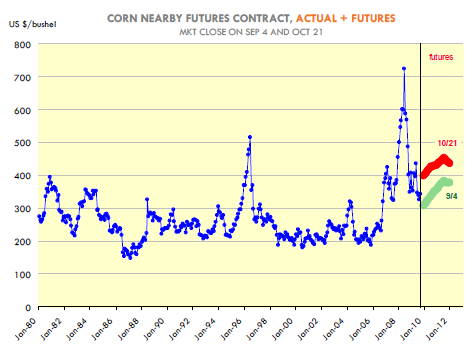



CME: Ethanol Uses as Much Corn as Livestock
US - According to Steve Meyer and Len Steiner, the US corn harvest continues to track well below year ago and five year average levels, raising concerns not just about current harvest output potential but also the ability of farmers to do enough fall field work to prepare for spring plantingsAdding to the poor harvesting pace is the further weakening of the US dollar and all that it implies for exports as well as energy prices. While the feed/energy link may not be as strong as it was back in 2007, it is still very important as ethanol is currently almost as big a user of corn as the livestock and poultry industry.
The latest USDA crop progress report indicated that as of 18 October, only 17 per cent of the US corn crop had been harvested, compared to 28 per cent a year ago and 46 per cent average for the previous five years. In some areas, such as Minnesota, North Dakota, Wisconsin, harvest has only just started. In Illinois, the second largest corn producing state, only 11 per cent of the crop has been harvested so far, compared to the 68 per cent average for the previous five years. Indiana and IA, are at 15 and 10 per cent, respectively, well behind normal harvest progress.
Futures have jumped higher in response to the current delays in harvest and prospects of more wet weather in the forecast. December corn closed on 21 October only 2 cents shy of the $4 per bushel mark. In early September, Dec futures were a little over $3 per bushel and there was plenty of speculation about sub $3 corn going into a harvest that was expected to produce the largest corn crop ever (please see chart below).

The latest USDA and private forecasts continue to indicate a record corn crop but the market remains dubious given the harvest delays and the potential for output loss. And the concern is not just about the ability of combines to get into very wet and muddy fields to harvest the current crop but also the ability of farmers to dry a crop with a very high moisture content. Much of the current speculation in the marketplace focuses on weather forecasts for the next two weeks which show only limited windows of good weather, not nearly enough to make up for lost time.
Finally, the market also is calculating the acres needed for next spring in order to maintain adequate stock levels. Energy prices have been trending higher and some forecasts are now pointing to $100 crude in 2010. If such price levels materialize, and that remains a big if given the wobbly US economic conditions, it could boost demand for oil from ethanol producers as well as raise breakevens for grain producers.









